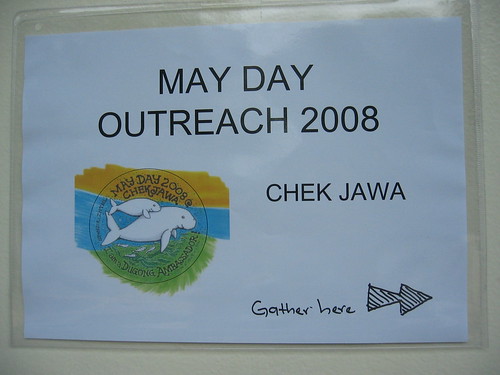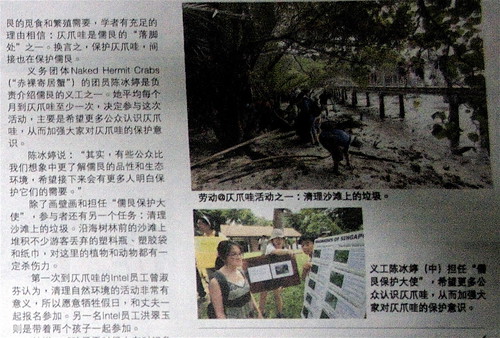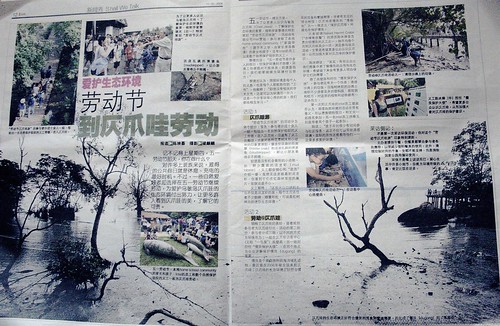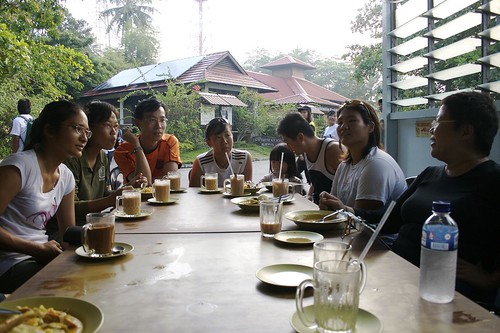 |
| Source: Singpost News Release [PDF] |
There were of course other stamp series inspired by Ubin before, such as the Chek Jawa nature series [PDF] from 2004 which celebrated the beauty of Chek Jawa's biodiversity. One does lament though that it hardly provides any glimpse of the Ubin landscape except for the faint beacon in the background, if you can spot it!
 |
| Source: Singpost News Release [PDF] |
Other Related Reads:
Singpost Press Release - A Glimpse into the Islands of Singapore - Pulau Ubin Through Stamps [PDF]
----
Four landmarks showcased on stamps: Main Jetty, Chek Jawa, The Wayang Stage and a Quarry
Channel News Asia, 17 Jul 2014
SINGAPORE: A series of stamps depicting Pulau Ubin’s iconic landmarks will be available from Friday (July 18).
The stamps, launched by SingPost and the National Heritage Board, feature images of four landmarks: The Main Jetty (2nd local), Chek Jawa (S$0.65), the Wayang Stage (S$0.80) and a Quarry (S$1.10).
The complete set is priced at S$2.87. Other products include a Pre-Cancelled First Day Cover affixed with the complete set of stamps, priced S$3.70, and a Presentation Pack with the complete set of stamps, priced at S$4.65.
The new stamp issue, Islands of Singapore – Pulau Ubin, will be available at all post offices, the Singapore Philatelic Museum and online at www.stampdelight.com.
----
A Glimpse into the Islands of Singapore - Pulau Ubin Through Stamps
Singpost News Release [PDF]
Singapore, 17 July 2014 - The boomerang shaped Pulau Ubin, Singapore’s second largest offshore island, lies on the Straits of Johor off the north-eastern coast of Singapore. It was once known as Granite Island. Four of its iconic landmarks are captured in this stunning new stamp issue, Islands of Singapore - Pulau Ubin. SingPost and the National Heritage Board (NHB) collaborated to launch this series of stamps which comes in four denominations - 2nd Local, S$0.65, S$0.80 and S$1.10.
Main Jetty (2nd Local)
The main jetty on Pulau Ubin was first built by the Japanese between 1942 and 1943, and rebuilt in 1965. In 1978, a new jetty was built which was upgraded in 1994 to include a shelter and a seating area. Ferry services between Pulau Ubin and Singapore are provided by licensed bumboat operators.
Chek Jawa (S$0.65)
Chek Jawa, located at the eastern tip of Pulau Ubin, is a natural beach that is teeming with marine wildlife. It is also one of Singapore’s richest ecosystems with six distinct habitats including mud and sandflats, mangrove, coastal forest, lagoon, coral rubble and a small island called Pulau Sekudu. The beauty of Chek Jawa lies in the fact that several different ecosystems exist in a small area. These ecosystems, the plants and animals found there, are no longer common in mainland Singapore. It is a popular natural heritage destination and boasts a visitor centre, over 1 kilometre of boardwalk and the Jejawi Tower.
The Wayang Stage (S$0.80)
The Wayang Stage on Pulau Ubin is located at the centre of Ubin village. The stage was originally a simple wooden structure with an attap roof but was rebuilt in 1939 and 1971. It was once a classroom for the children during the 1960s as well as a venue for election rallies. Today, it is still used for performances three times a year namely, during the fourth month of the lunar calendar, Vesak Day and Hungry Ghost Festival.
A Quarry (S$1.10)
Pulau Ubin was one of two main granite quarrying sites in Singapore and accounted then for approximately 25% of the granite reserves in Singapore. The mining of granite on the island started in mid 1840s and by the 1850s, government quarries were established and convicts were deployed to mine granite for the construction of historically important structures including Horsburgh Lighthouse on Pedra Branca (1851), Fort Canning (1858), Raffles Lighthouse (1855), Singapore Harbour (1913), the Causeway (1923), and Fort Canning Reservoir (1926). By 1934, there were at least ten operating quarries on Pulau Ubin. The mining of granite ceased in the 1960s with the last quarry on Pulau Ubin closed in 1999. Since then, all defunct quarries have become scenic lakes.
The complete set of stamps is priced at S$2.87. Other products include a Pre-Cancelled First Day Cover affixed with the complete set of stamps (S$3.70), and a Presentation Pack with complete set of stamps (S$4.65).
The Islands of Singapore - Pulau Ubin stamp issue is available from tomorrow, 18 July 2014 at all post offices, the Singapore Philatelic Museum and online at www.stampdelight.com. Please refer to Annex 1 for more information.
Pulau Ubin Commemoration Efforts
The Ministry of National Development (MND) has recently launched The Ubin Project to gather public feedback and work with the community to preserve and sensitively enhance the island, so that Pulau Ubin remains an enjoyable rustic destination for all.
In May this year, a broad network of stakeholders was formed to share their ideas on how to continue to enhance Ubin as a rustic sanctuary that is both charming and unique. Called the Friends of Ubin Network (FUN), it included members of various heritage and nature groups, socio-anthropologists, students and volunteers.
The Ministry has also launched a microsite for Singaporeans to share their ideas on how to enhance the island’s natural environment, biodiversity and history. The Ministry has received a number of good feedback thus far and will be studying these suggestions in detail. Members of the public who wish to find out more about the charming island and join in the Ubin conversation may visit the microsite at www.mnd.gov.sg/ubin.
On its part, NHB produced a documentary on the boat operators of Pulau Ubin as part of its Heritage In Episodes series and developed a virtual tour of Pulau Ubin’s main hub (around the jetty area) as part of its Walking Through Heritage series (https://www.nhb.gov.sg/NHBPortal/Resources/WalkingThroughHeritage/PulauUbin).
In addition, NHB collaborated with National Parks Board to showcase Pulau Ubin as part of the “Stories from Singapore’s Islands” exhibition currently on display at the National Museum of Singapore from 2 June to 10 August 2014.





























